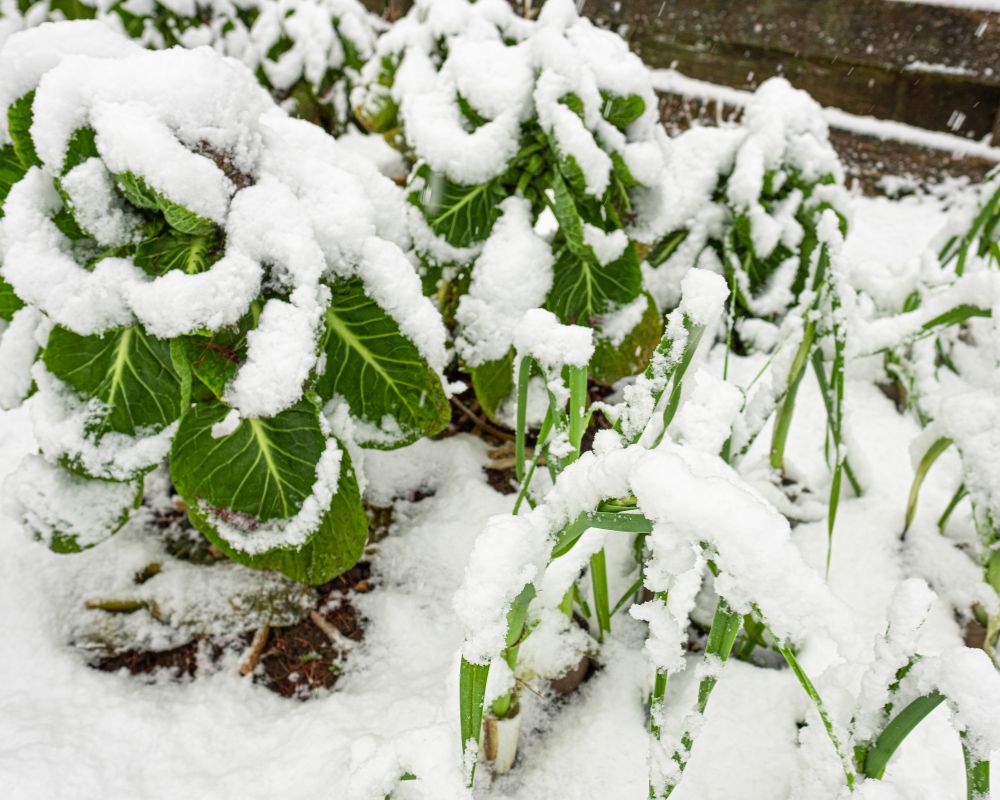Winterize Your Garden: How to Prepare Your Garden for Winter

How to prepare your garden for winter. Did you know that properly preparing your garden for winter can mean the difference between thriving plants in the spring or a disappointing garden comeback? With the colder months approaching, it’s essential to take the necessary steps to protect your garden and ensure its survival through the winter.
In this comprehensive guide, we will walk you through the crucial tasks and effective strategies to winterize your garden. From cleaning up the garden to shielding your plants from freezing temperatures, we have all the winter garden preparation tips you need. Let’s get your garden ready for the winter months!
Table of Contents
Understanding the Importance of Garden Winterization

Garden winterization is a critical step in ensuring the health and survival of your plants during the harsh winter months. By adequately preparing your garden for winter, you can protect your plants from freezing temperatures, frost damage, and other winter-related challenges. Winterizing your garden has numerous benefits, including:
- Preserving plant health: Winterizing your garden helps to maintain the vitality and well-being of your plants. By taking proactive measures, such as insulating plants and providing adequate mulch, you can minimize the risk of cold damage and promote healthy growth in the spring.
- Preventing disease and pests: A well-winterized garden is less susceptible to the spread of diseases and pests. By cleaning up garden debris and removing any affected plants, you can reduce the risk of infestations and ensure a healthier garden next season.
- Enhancing plant resilience: Winterizing your garden strengthens the strength of your plants, enabling them to withstand and recover from winter conditions more effectively. By protecting the root systems and creating a favorable microclimate, you give your plants the best chance to thrive when the warmer weather returns.
- Lessening spring cleanup: Properly winterizing your garden can save you time and effort in spring. By clearing garden beds, pruning shrubs, and addressing any maintenance tasks before winter, you’ll have a head start when it’s time to prepare your garden for the growing season.
The Right Timing for Winter Garden Preparation
Preparing your garden for winter requires careful timing to ensure optimal results. By understanding your climate zone and recognizing key signs, you can determine when it’s time to winterize your garden and protect it from the harsh winter conditions.
1. Identifying Your Climate Zone
Every region has its unique climate characteristics, which influence the timing and extent of winter weather. To accurately determine when to prepare your garden for winter, identify your climate zone using the USDA Plant Hardiness Zone Map or other local resources. This will provide valuable information on the average dates of frost and the duration of freezing temperatures in your area.
2. Key Signs That It’s Time to Winterize
While climate zone information is helpful, there are also key signs that indicate when it’s time to start your winter garden preparations. Pay attention to the following indicators:
- Dropping temperatures: As the temperatures start to decline consistently, it’s a signal that winter is approaching, and your garden needs protection.
- Changes in foliage color: When you notice the leaves of your plants turning yellow or brown, it indicates that they are preparing for the dormant period. This is a clear sign that winterization activities should begin.
- Shorter daylight hours: With the arrival of winter, daylight hours become more straightforward. This decrease in daylight triggers physiological changes in plants, signaling the need for winter care.
By monitoring these signs and identifying your climate zone, you can time your winter garden preparation appropriately and ensure the best possible outcome for your plants.
How to Prepare Your Garden for Winter: A Step-by-Step Approach

In this section, we will provide you with a detailed, step-by-step guide to preparing your garden for winter. By following this comprehensive approach, you’ll ensure that your garden is ready to withstand the cold months and flourish when spring arrives.
Cleaning Up the Garden
Prior to the arrival of cold weather, it’s crucial to tidy up your garden and clear away any weeds and debris. Doing so will eradicate potential shelters for pests and diseases. Make sure to prune your perennials and annuals, trimming them down to the ground. Additionally, be sure to dispose of any diseased plants appropriately in order to prevent the spread of infections.
Protecting Your Plants
Now that your garden is clean, it’s time to protect your plants from the harsh winter conditions. Start by applying a layer of mulch around the base of your plants to insulate the soil and retain moisture. This will help prevent your plants’ roots from freezing. Additionally, consider wrapping vulnerable plants with burlap or frost blankets to provide an extra layer of protection against freezing temperatures and wind.
Caring for Your Irrigation System
Proper care of your garden’s irrigation system is crucial to prevent damage during winter. Begin by shutting off the water supply to outdoor faucets and draining all the hoses and pipes. It’s also important to insulate any exposed pipes to prevent freezing. If you have an underground irrigation system, use an air compressor to blow out any remaining water from the lines.
Fertilizing Before the Freeze
Give your plants a nutrient boost before the winter freeze by applying a slow-release fertilizer. This will provide them with the necessary nutrients for healthy growth during their dormant period. Follow the instructions on the fertilizer package for the correct application rate and timing. Avoid fertilizing too late in the season, as it may stimulate new growth that is susceptible to damage from frost.
Monitoring and Maintenance
Even after winterizing your garden, it’s important to monitor its condition throughout the cold months. Keep an eye on temperature fluctuations and be prepared to provide additional protection if needed. Check for signs of pests and diseases, as they may remain active even in the winter months. Take necessary actions to manage and prevent them in order to maintain the well-being of your plants.
Cleaning Up the Garden Before the Cold Sets In
Before winter arrives, it’s essential to clean up your garden to promote healthy plant growth in the following seasons. This includes removing weeds and debris that can harbor pests and diseases. Additionally, managing your perennials and annuals in preparation for winter is crucial to ensure their survival. We’ll provide you with the necessary steps and tips to complete these tasks effectively.
Removing Weeds and Debris
To prepare your garden for winter, start by removing weeds and debris that can hinder plant growth and attract pests. Follow these steps:
- Clear away fallen leaves, branches, and any other organic matter.
- Pull out weeds from the root to prevent regrowth.
- Please dispose of the weeds and debris properly to avoid reintroducing them to your garden.
By removing weeds and debris, you create a clean environment for your plants and reduce the risk of diseases and pests.
Managing Perennials and Annuals Pre-Winter
Properly managing your perennials and annuals is essential for their survival during winter. Consider these tips:
- Trim back dead foliage and stems to promote healthy growth in the next season.
- Divide and replant overcrowded perennials to encourage better airflow and prevent disease.
- Apply a layer of mulch around the base of your perennials to protect their roots from freezing temperatures.
- Remove any spent annuals and dispose of them properly.
By managing your perennials and annuals before winter, you ensure that they remain healthy and have a higher chance of thriving when spring arrives.
Steps to Prepare Your Garden for Winter: Shielding Plants
Protecting your plants from freezing temperatures is a crucial step in preparing your garden for winter. By implementing the right techniques, you can shield your plants from cold damage and ensure their survival. Here are some effective garden winterization techniques to help you safeguard your plants:
- Mulching: Add a covering of mulch at the bottom of your plants to keep the soil insulated and retain moisture. This will assist in maintaining soil temperature and safeguarding the roots from freezing.
- Wrapping: For delicate plants and shrubs, consider wrapping them with burlap or frost blankets. This protective layer acts as a barrier against freezing winds and extreme temperatures.
- Constructing protective barriers: Create windbreaks or physical barriers around vulnerable plants using materials like stakes, mesh, or plastic. These barriers help reduce cold drafts and provide added protection.
Implementing these shielding techniques will create a stable microclimate around your plants, shielding them from freezing temperatures and preventing cold damage. By taking these essential steps, you can ensure that your garden remains healthy and vibrant throughout the winter months.
Winterizing Garden Containers and Pots
If you have garden containers and pots, it’s important to take special measures to protect them during the winter months. Here, we’ll explore different strategies for winterizing your garden containers and pots to ensure their survival.
Indoor Transfer vs. Outdoor Protection Strategies
When it comes to winterizing garden containers and pots, you have two main options: transferring them indoors or implementing outdoor protection.
Indoor transfer: If you have space available, consider bringing your containers and pots indoors for the winter. This will provide optimal protection against freezing temperatures and harsh weather conditions. Place your plants in a location with sufficient sunlight and maintain proper watering and care.
Outdoor protection: If transferring your containers indoors is not feasible, you can implement various outdoor protection strategies. Here are some techniques to consider:
- Grouping containers: Cluster your containers together in a sheltered area to create a microclimate that offers greater warmth and protection.
- Mulching: Apply a layer of mulch around the base of your container plants to insulate the roots and conserve moisture.
- Wrapping: Wrap your containers with burlap or frost blankets to shield them from freezing temperatures and wind.
- Elevating: Place your containers on pot feet or risers to elevate them above the ground. This helps improve drainage and prevents waterlogging, which can lead to root rot.
- Using insulation: Insulate your containers by wrapping them with materials such as bubble wrap or foam. This provides an extra layer of protection against extreme cold.
Insulation Techniques for Container Plants
Insulating your container plants is essential for protecting their roots from freezing. Here are some effective insulation techniques to consider:
- Using straw or shredded leaves: Fill the gaps between the pots and containers with straw or shredded leaves to create insulation and retain heat.
- Double potting: Place smaller containers inside larger ones, filling the space between them with insulation materials like pine needles or wood chips.
- Using plant jackets or frost cloths: Cover your container plants with specialized plant jackets or frost cloths designed to provide insulation and protection from frost.
- Wrapping the roots: Wrap the root balls of container plants with insulating material like burlap or bubble wrap to shield them from freezing temperatures.
Protecting Your Garden for Winter: The Role of Plant Covers

In order to safeguard your garden from the harsh winter weather, plant covers play a vital role. These protective covers act as a shield against freezing temperatures, frost damage, and other winter-related challenges. In this section, we will explore the different types of plant covers available and guide you on how to choose the right covers for your specific plants and garden layout. We will also offer some DIY cover solutions that you can easily implement to ensure the well-being of your winter garden.
1. Choosing the Right Plant Covers
When selecting plant covers for winter protection, it is important to consider the specific needs of your plants and the prevailing weather conditions in your area. Here are some factors to keep in mind:
- Material: Plant covers are available in various materials, such as burlap, agricultural fabric, and plastic. Choose a material that provides adequate insulation while still allowing airflow.
- Size and Shape: Ensure that the covers are large enough to enclose the plants and fully protect them from cold winds. Consider using different-sized covers to accommodate plants of various heights and shapes.
- Durability: Opt for covers that are durable and can withstand the winter elements without tearing or degrading. This will ensure long-lasting protection for your plants.
2. DIY Cover Solutions for Your Winter Garden
If you prefer a do-it-yourself approach, there are several DIY cover solutions that you can easily create to safeguard your winter garden. Here are a few ideas:
- Homemade Cold Frames: Constructing cold frames using old windows or transparent plastic sheets can create a mini-greenhouse effect, trapping heat and protecting your plants from the cold.
- Cloches: Use glass jars, plastic containers, or cloche bells to cover individual plants and create a microclimate around them.
- Row Covers: Create row covers using floating row cover fabric or lightweight blankets, securing them over rows of plants to provide insulation and protection.
By utilizing these DIY solutions, you can customize the covers to fit your garden’s specific requirements and budget.
Getting Your Garden Ready for Winter: Irrigation System Care
Proper care of your garden’s irrigation system is crucial for winter readiness. Freezing temperatures can cause damage to pipes and sprinklers if they are not adequately prepared. In this section, we’ll guide you through the steps to winterize your irrigation system, including draining, insulating, and shutting off water sources. This will ensure that your system remains intact and ready to use when spring arrives.
Steps to Winterize Your Irrigation System
- Drain water: Begin by shutting off the main water supply and opening all valves to drain the water from the pipes.
- Insulate exposed pipes: Use pipe insulation or foam sleeves to protect any exposed pipes from freezing temperatures.
- Disconnect hoses and sprinklers: Remove all hoses and sprinklers from the system and store them in a dry location.
- Blow out the system: If you have access to an air compressor, use it to blow out any remaining water from the pipes to prevent freezing and damage.
- Shut off water sources: Finally, shut off the main water supply and any other water sources connected to your irrigation system.
By following these steps, you can protect your garden’s irrigation system from winter damage and ensure it is ready to perform efficiently when the warmer weather returns. Remember that each system may have specific requirements, so consult your manufacturer’s instructions or seek professional assistance if needed.
Garden Winterization Guide: Fertilizing Before the Freeze
Fertilizing your garden before the winter freeze is crucial for maintaining the health and vitality of your plants. During their dormant period, plants may still require essential nutrients to support their root systems and prepare for the upcoming growing season. In this section, we will explore the importance of winter fertilization and provide guidelines on when and how to fertilize your garden before winter sets in.
The Importance of Fertilizing Before the Freeze
Winter fertilization helps ensure that your plants have access to the necessary nutrients, even when their growth has slowed down. By providing adequate fertilization before winter, you can:
- Strengthen the root system: The nutrients delivered through winter fertilization contribute to strong and healthy root development, allowing plants to absorb water and nutrients efficiently.
- Promote nutrient storage: Fertilizing before the freeze helps plants store essential nutrients, which they can utilize during dormancy to support growth in the following seasons.
- Enhance disease resistance: Well-nourished plants are better equipped to resist diseases, pests, and harsh environmental conditions, ensuring their overall survival and resilience.
Winter Garden Fertilization Guidelines
When it comes to fertilizing your garden before winter, consider the following guidelines:
Timing: Fertilize your garden in late fall, approximately 4-6 weeks before the first expected frost. This timing allows plants to absorb and utilize the nutrients before going dormant.
Types of fertilizers: Choose a slow-release or organic fertilizer that provides a balanced blend of nutrients. Look for a formulation with adequate levels of nitrogen (N), phosphorus (P), and potassium (K) to support overall plant health.
Application techniques: Apply the fertilizer evenly across your garden beds, following the instructions provided by the manufacturer. Avoid overfertilizing, as this can lead to nutrient runoff and potential harm to the environment.
| Fertilizer Name | Nitrogen (N) | Phosphorus (P) | Potassium (K) |
|---|---|---|---|
| Organic Fertilizer A | 5% | 3% | 5% |
| Slow-Release Fertilizer B | 10% | 5% | 8% |
| Multi-Purpose Fertilizer C | 8% | 6% | 10% |
Note: The table above provides examples of fertilizers available in the market, showcasing their nitrogen (N), phosphorus (P), and potassium (K) content. Consult the packaging instructions for specific application rates and guidelines.
Winter Garden Care: Monitoring and Maintenance
Now that you’ve prepared your garden for winter, it’s important to continue monitoring and maintaining it throughout the cold months. Temperature fluctuations can still pose a threat to your plants, and pests may try to take advantage of the winter season. By following these winter garden care tips, you can ensure the health and survival of your garden.
Keeping an Eye on Temperature Fluctuations
During winter, temperatures can vary widely, even within a single day. It’s crucial to keep a close watch on these fluctuations, as they can impact your plants’ well-being. Make a habit of checking the weather forecast regularly and paying attention to temperature changes. If the temperature is expected to drop significantly, consider covering your most delicate plants or moving them to a more sheltered location.
Pest Control During the Winter Season
While the colder months may seem like a time when pests are inactive, some insects and rodents can still cause damage to your garden. Take proactive steps to protect your garden from winter pests. Remove any plant debris, fallen leaves, and hiding places that could attract pests. Additionally, consider applying organic pest control measures to deter pests without harming your plants or the environment. Regularly inspect your garden for signs of pest activity, such as chewed leaves or nibbled stems. Should you notice any pests, take immediate action to prevent an infestation.


